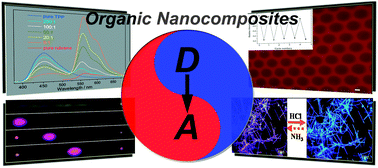Composite nanomaterials fabricated from organic luminescent molecules have generated wide research interests during the past few years. These optically active binary nanostructures are of great importance not only for fundamental investigations on energy transfers, but also for various practical applications in light emitting, optical waveguiding, fluorescence switching and chemical sensing. Therefore, many kinds of organic composite nanostructures have been synthesized by different techniques, including liquid-phase mixing, vapor-phase doping, chemical reaction and surface modification. In this Focus, we describe the recent progress in our group toward the construction of organic composite nanomaterials and studies on their tunable luminescent behaviors via energy transfers.
You have access to this article
 Please wait while we load your content...
Something went wrong. Try again?
Please wait while we load your content...
Something went wrong. Try again?


 Please wait while we load your content...
Please wait while we load your content...